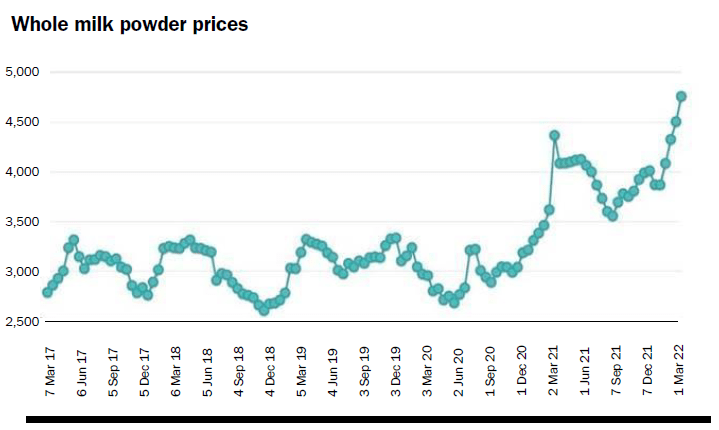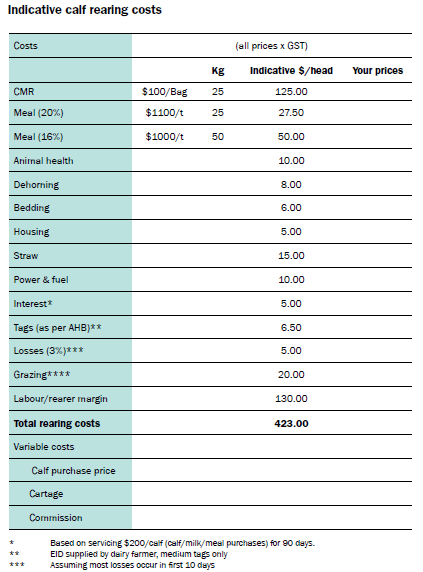Calf rearing in a volatile world
Paul Muir and staff from On-Farm Research at the Poukawa Research Farm in Hawke’s Bay have been researching the calf rearing market since 1996. They have put together an update of how they think the market for calf rearing will look in the 2022/23 season.

Estimates for the final 2021/22 milksolids payout are about $9.60/kg. For a Friesian cow with a milksolids content of 8%, this makes milk worth 77 cents/litre. As Jersey milk has a higher milksolids content (typically 9.8%) Jersey milk is worth about 94 c/l. At this price vat milk is less likely to be used to rear calves.
CMR supply and prices
As the dairy commodities price market is at record levels (see graph for whole milk powder prices) it is not surprising that premium milk powders are also well-priced. Premium milk powders range from $95-$102 per bag (excl GST). These are for tonne rates and the cost is unlikely to include farm delivery except when reasonable tonnages are ordered for delivery close to town.
While CMR prices seem high, a glance back to the archives (our newsletters) showed that premium CMR prices ranged from $80 to $95 in June 2001 and reached $100 that spring.
This was a result of the Foot and Mouth outbreak in the United Kingdom meaning no CMR component ingredients could be imported from the European Union.
This led to a strong export demand for New Zealand-produced ingredients. CMRs became so scarce that in mid spring, food grade whole milk powder was eventually released on to the market for calf rearing.

Non-curding or whey powders have also increased in price but are still typically $20/bag cheaper than premium casein CMRs.
The number of whey products has increased and most (80%) are imported but a few brands are formulated in NZ. At present, these brands are typically a blend of whey powders and infant formula which was unable to be marketed in China because of their current Covid lockdown and recent scares about the quality of infant formulas. Current prices for non-curding powders range from $75-$82 per bag (excl GST).
Our recommendations are the same as in other years – feed a curding powder for the first few weeks then switch to non-curding milk powder if you need to cut costs.
Once calves are two or three weeks old, they are starting to develop both their rumen and immune systems and are better able to handle non-curding powders.
Pick a premium powder that curds. A curd test is simple to apply if you can find some rennet in the local supermarket – though often it’s hard finding someone who knows what rennet is!
A simple curd test involves making up 500ml of milk replacer as per the instructions on the bag. Keep at 39C (set the oven and use a thermometer) and then add 5ml of rennet.
A good curd should have formed within 20 minutes. Do the same with some blue top milk so you can see what a really good curd should look like – though it is unlikely any milk replacer will ever curd as well as whole milk.
At $100/bag of premium CMR reconstituted at 125g/litre works out at 62.5 cents/litre and at $80/bag of non-curding CMR works out at 50c/l. When the price of whole milk is 77c/l this is likely to result in more dairy farmers switching from vat milk to CMR, particularly later in the season.
If this happens it is likely to put more pressure on both the supply and price of CMR. Given the current world volatility and the obvious constraints on supply chains, this may well be a good year to order your CMR early.
Calf meals
Most rearers will find themselves paying in excess of $1000/T for meal. Current pricings appear to be around $1030-$1050 plus GST for 16% protein pellets in 25kg bags and $1050-$1100 plus GST for 20% protein pellets, excluding delivery.
There can be discounts of up to $150/T for bulk orders. Because of the uncertainty around supply and cost of imported ingredients that go into calf meals, few suppliers will guarantee prices beyond June.
Calf prices
Normally autumn-born calves are sought after as by summer they are often 100kg heavier than spring born calves and have a better shot at handling the lower quality summer forage.
Reduced availability of these calves means sale prices (May) are around $150 for the better Friesian calves. Spring calf prices will, as always, reflect supply and demand.
Rearers: When we surveyed calf rearers back in 2003, we found there was a 20% turnover of rearers largely because of a lack of profitability. It is hard to imagine much has changed since then. This supply chain issue could be solved with rearing contracts but there are still very few contracts on offer. Many farmers don’t want to farm calves through the summer so simply look to buy calves in autumn. Supply and demand means the price of weaners usually falls rapidly in November/December leading to poor profitability for the rearer.
Rearing cost
It is always difficult to provide an accurate indicator of calf rearing costs as every situation is different. Some rearers have ready access to cheaper calves and/or low-cost whole milk. Larger rearers get better discounts on milk and calf meals and have economies of scale with labour. Large rearing sheds may have a higher capital cost but reduced labour costs/calf. There will be differences in mortality and animal health costs which all impact on the bottom line. Nevertheless, we have tried to provide an estimate of costings.
The milk powder price is about $100/bag this year. While the aim might be to feed one bag of CMR, the reality is this seldom occurs – there are small or late calves which take more CMR. So we have used a CMR price of $100/bag, 25kg/calf and a CMR cost/calf of $125 per calf. This assumes a casein-based CMR is fed throughout the rearing. However, switching to a budget CMR for the last two or three weeks of rearing has the potential to save $10/calf.
Our indicator budget is for a system feeding out 75kg of meal – 25kg pre weaning and 50kg post weaning. It is worth noting there would be a number of rearers on limited land areas feeding out higher quantities of pellets, with grass becoming a much smaller component of their system.
A typical Friesian bull calf will consume around 100kg of grass drymatter between weaning and when it leaves the property. We have valued this at 20c/kg DM to reflect the lost opportunity cost from grazing other stock.
We have used $130 as a rearer margin. This means “fixed” costs of rearing are about $425 per calf. Variable costs of calves, cartage and commission at point of selling also have to be considered. Assuming $100 for a good early spring calf, it seems a rearer will need to secure their CMR, meal and calves and achieve a return in excess of $525/calf to be profitable.
- For more information www.on-farmresearch.co.nz or Facebook – Calf Rearing NZ
In 1996 it looked like very few calves were going to be reared and Poukawa started evaluating lower cost rearing systems and did much of the pioneering work on once-a-day feeding which allowed the calves to be reared economically at scale. Since 1996 around 8000 calves have been reared on a wide range of trials – covering effects of colostrum, milk feeding systems, meal type, roughage and calf breed on calf performance. Much of this is covered on the website www.on-farmresearch.co.nz.





